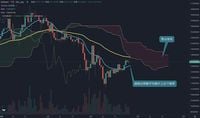In the ever-volatile world of cryptocurrency, Bitcoin has recently made headlines with its dramatic price fluctuations. After a sharp drop to $78,000, Bitcoin has rebounded to the $88,000 range, sparking renewed bullish sentiment among investors. However, this recovery comes with a significant caveat: the health of the Bitcoin network, as highlighted by Fidelity's Jurrien Timmer, who warns that the number of wallets—a key indicator of network vitality—has barely increased over the past year.
On March 26, 2025, Bitcoin's daily closing price exceeded its 14-day exponential moving average (14EMA), suggesting a short-term bullish trend. The day's closing price was recorded at 13.1 million yen, reflecting a slight decline of 0.1%. Although this marks two consecutive days of negative movement, the decline was marginal, indicating resilience in the market.
Technical indicators present a mixed picture. Oscillator-based indicators are trending upwards, with the Commodity Channel Index (CCI) surpassing 100 for the first time in two months. Additionally, the Fisher Transform is showing positive momentum, crossing above its lagging line. Meanwhile, the long-term oscillator, the Moving Average Convergence Divergence (MACD), is on an upward trajectory, potentially recovering into positive territory next week.
Despite these positive signals, the ADX volatility index has seen a rapid decline, now standing at 29%. This drop suggests a weakening of the bearish trend that had been affecting Bitcoin since February 2025. The market is currently experiencing a range-bound movement, which is not entirely negative, as it indicates a consolidation phase.
However, the recovery in Bitcoin's price raises questions about the underlying dynamics driving this trend. Timmer points out that the lack of growth in wallet numbers suggests that the recent price increases may be more attributable to institutional activity rather than widespread adoption by individual investors. This is a crucial distinction, as it implies that the price surge could be unsustainable if not supported by a broader base of users.
Institutional investors have been increasingly active in the Bitcoin market, particularly following the approval of spot Bitcoin ETFs. This has led to a concentration of assets in fewer, larger wallets, contrasting with the decentralized ethos that Bitcoin was built upon. MicroStrategy's strategic buying has further fueled demand, yet the growth in unique addresses on the network has remained limited.
As the market sentiment shifts towards bullishness, the stagnation in wallet growth poses a significant concern. Timmer emphasizes that true adoption of Bitcoin requires participation from a wide range of end-users. The current disconnect between network size and price raises structural questions about the cryptocurrency's long-term viability.
Bitcoin's value assessment, according to Timmer, is based on the 'power law model,' which posits that as the number of users increases, the value of Bitcoin should rise exponentially. This theory aligns with Metcalfe's Law, which describes the growth curve of traditional network technologies. While Timmer expresses confidence in this model, he acknowledges the challenges in tracking future adoption trends, especially given the concentration of holdings among institutional investors.
Furthermore, the power law model, while theoretically sound, may not fully account for the complexities of the cryptocurrency market, which is influenced by non-quantitative factors such as regulations, market sentiment, and speculative demand. If the gap between perceived adoption and theoretical models widens, investor confidence could wane, necessitating new evaluation methods that do not rely solely on mathematical predictions.
Chris Kuiper of Fidelity Digital Assets highlights that Bitcoin's performance over the past four years has not met expectations. Despite maintaining a compound annual growth rate (CAGR) of 17%, the volatility—nearly four times that of the S&P 500's 13%—is a significant risk factor. If risk-adjusted returns remain limited, investment funds focused on stability may shift their assets elsewhere, particularly pension funds that prioritize long-term security.
While Bitcoin's status as a growth asset remains intact, the current landscape calls for a reevaluation of how it aligns with risk tolerance. Kuiper notes that the past four years have been 'worse compared to past cycles,' yet he also acknowledges the potential for cycle extension, leaving room for bullish sentiment to persist. However, if the disparity between market expectations and reality continues to grow, the risk of short-term adjustment pressures cannot be dismissed.
In conclusion, the Bitcoin market stands at a crossroads. The recent price recovery to $88,000 has reignited optimism, but the underlying health of the network raises critical questions about the sustainability of this trend. As institutional investors play a more prominent role, the need for genuine adoption among everyday users becomes increasingly urgent. The future of Bitcoin will likely depend on its ability to bridge the gap between institutional activity and grassroots participation.





